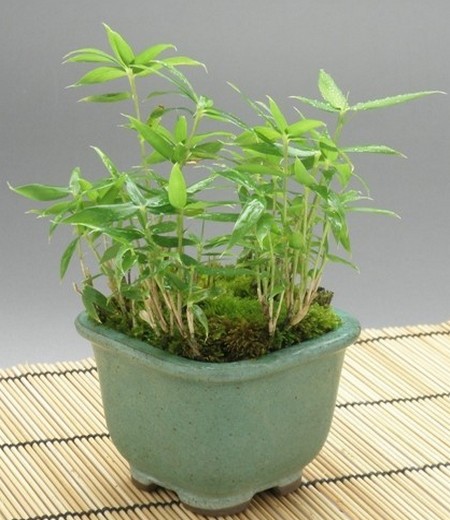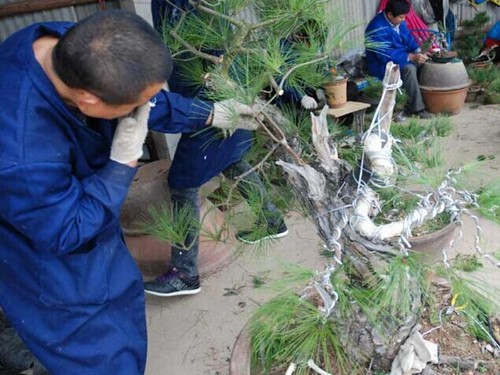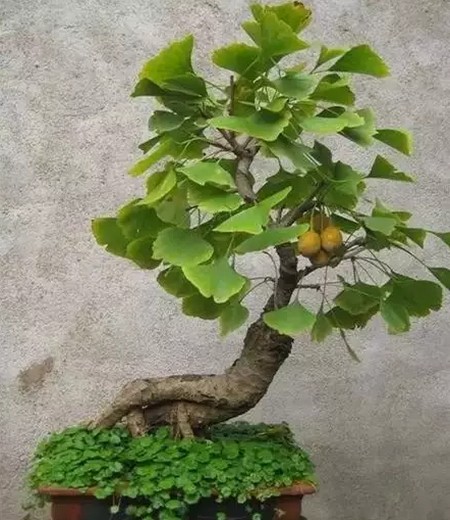Production method of Purple Bamboo Bonsai
Purple bamboo, also known as black bamboo, black bamboo, scattered bamboo, it is a view of bamboo stem, bamboo stem purple black, soft shiny, hidden in the green leaves under, very beautiful. You can see it and remember its name. Not only can it be planted in bamboo garden together with yellow groove bamboo, golden jade bamboo, mottled bamboo and other bamboo species with colorful stems to add color variation. Potted plants can also be placed in front of the window, a few, do not have some fun. It not only has an ornamental role, but also a medicinal plant, but also can be made into small furniture or fishing rods, walking sticks and musical instruments and other items.

Bamboo is a kind of plant that Chinese garden likes to use more, bamboo branch pole is tall and straight, slender, all the year round green Cui, Ling frost proud rain, much loved by everyone, more have "plum orchid bamboo chrysanthemum" four gentleman,"plum pine bamboo" cold three friends and so on. A few purple bamboos or pots of purple bamboos are planted in the home or garden, and the cultural charm is even more.
Select Purple Bamboo
Although bamboo bonsai production can choose a variety of bamboo, but people in the selection of materials, often choose purple bamboo. Because, ancient folk spread "Guanyin was born in the purple bamboo forest" legend, so, some people think, purple bamboo can ward off evil, in the courtyard there is purple bamboo, then hundreds of oblique Mo invasion, evil far away. In fact, purple bamboo plants are small, in the garden bamboo category, this bamboo should be planted in the courtyard between the rocks or study, hall, path, pool water, can also be planted in the basin, placed in front of the window, a few, do not have a taste. Purple bamboo stems purple black, green leaves, but also quite unique.
dwarfing treatment
1. Breeding dwarfing (bamboo rhizome dwarfing in pot). In the practice of bamboo production, the bamboo grown by dwarfing the bamboo rhizome is obviously lower than the bamboo grown naturally. The bamboo rhizome is buried in a pot, covered with 5 to 10cm of soil, and kept humid. The bamboo grown in the natural climate is only 1/15 to 1/9 of the natural height. However, although the bamboo grown in this way is elegant and gentle, but the stem is thin, it appears weak, has the feeling of slender plain girl, and is liked by elegant literati and ladies.
2. Stripping shoots and dwarfing (field cultivation). There is a phenomenon in bamboo growth that once the outer sheath is removed, the internodes of this bamboo become shorter. If one or two sheaths are gradually peeled from the base when the shoot grows to 20cm, each internode becomes shorter and the whole bamboo becomes shorter.
In practice, because bamboo is a shade-loving, water-loving plant, bamboo grows faster after rain; after rain, high temperature, it grows faster. Therefore, if you want internode growth evenly, you should master the number and time of peeling sheaths. One shift is to strip one sheet every afternoon at normal equilibrium temperature. If high temperature, high humidity will be stripped one in the morning and evening. It is important to note that do not peel too much at a time, resulting in bamboo shoots losing water or infected with bacteria and death. The time interval of sheath stripping is too long, the dwarfing effect is not ideal, the time interval of sheath stripping is too short, the internode is too short or it causes fracture. How to accurately master the time and number of sheath peeling is mainly based on local climate change conditions and growth speed to flexibly master
3. Dwarfing agent treatment. In garden practice, scientists have studied and experimented with dwarfing agents to treat bamboo. One method is to spray bamboo directly at high growth, which can reduce its height by one-third to two-fifths. Another method is to inject dwarfing agent into bamboo shoots with injection needles and needles.
The dosage and concentration of the injection is also determined by the growth rate of the bamboo. Because the temperature and humidity vary from day to day, bamboo grows tall enough in only two weeks during its shoot formation, and its growth rate varies from day to day. How to accurately master it depends on the characteristics of local bamboo growth. Furthermore, the proportion and type of dwarfing agents vary. If you master it properly, you should use it flexibly according to your own long-term observation and experience summary. If used properly, the internode can reach 3 cm, the whole internode is uniform, and the thickness is consistent; or the dosage can be controlled according to the thickness required by oneself.
Plastic and management
1. Transplant after dwarfing. After dwarfing in bamboo forest or field, purple bamboo needs transplanting. When transplanting, choose sunny weather to avoid bacterial contamination as much as possible. When digging, take more soil; it is best to take out the soil ball.
2. False planting. After taking out the dwarf purple bamboo in the field, do not plant it directly in the pot. It is necessary to plant it in an outdoor environment close to the large pot to recover the root damage caused by digging and improve the adaptability to the new environment.
3. Plastic cultivation. Dwarf purple bamboos still need photosynthesis from the leaves to provide nutrients. Too many branches and leaves consume more water, and at the same time, the shape also needs some branches and leaves to decorate. Therefore, according to their own modeling needs to retain the appropriate branches and leaves.
4. Transplant. Choose the appropriate size, water absorption, water permeability good pot: the best choice of early spring time transplanting, at this time the temperature rises, transpiration is small, capillary roots easy to revive.
5. Management. Maintain moderate sunlight, avoid exposure; do not lack water and water. Select fully decomposed cake fertilizer, compost, poultry manure, can also choose to apply 1% ammonium sulfate or 5% urea. 0.5% potassium dihydrogen phosphate can also be sprayed on the leaves every week for three consecutive weeks.
Time: 2019-05-26 Click:
- Prev

Production method and matters needing attention of Masson Pine Bonsai
Pinus massoniana, also known as Pinus massoniana, is a common tree species, but the material that can make bonsai is relatively rare. Mainly for construction, sleeper, pillar, board, packing box, furniture and wood fiber industry (rayon pulp and papermaking) raw materials. Pine resin can be cut from the trunk, which is used as raw material for medicine and chemical industry. The root is rich in resin.
- Next

Production technology of bonsai of ginkgo biloba
Ginkgo hanging fruit bonsai can be divided into: one branch alone (single branch), two wings flying (two branches), and three tripods (three branches). As the saying goes: if you have children, you will not plant ginkgo orchards, which means that only grandchildren can benefit from ginkgo trees. It can be seen that ginkgo trees grow slowly and bear fruit late. Generally speaking, the forming result of ginkgo bonsai is slower and later.
Related
- Fuxing push coffee new agricultural production and marketing class: lack of small-scale processing plants
- Jujube rice field leisure farm deep ploughing Yilan for five years to create a space for organic food and play
- Nongyu Farm-A trial of organic papaya for brave women with advanced technology
- Four points for attention in the prevention and control of diseases and insect pests of edible fungi
- How to add nutrient solution to Edible Fungi
- Is there any good way to control edible fungus mites?
- Open Inoculation Technology of Edible Fungi
- Is there any clever way to use fertilizer for edible fungus in winter?
- What agents are used to kill the pathogens of edible fungi in the mushroom shed?
- Rapid drying of Edible Fungi

